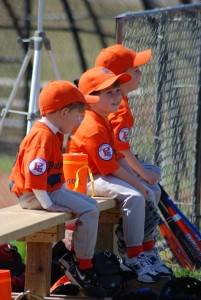What is a leader? Who is a leader?
In this lesson our goal is to teach the kids that they are all leaders. As early as pre-school kids know there’s something special about being “the line leader.” It’s exciting to have the class follow them. However, it’s not the number of people following that makes one a leader; it’s the actions that result from the choices made. If a child makes a decision and acts on it, he/she has led themselves even if no follows. Therefore, every child on your team is a leader that influences his/her own behavior as well as those around them. In subsequent lessons, we will discuss how to lead but at this point we simply want them to believe that they are leaders.
Coach: Can anyone tell me what a leader is?
The players will offer a multitude of answers. During the discussion, provide positive feedback to encourage and facilitate a conversation.
Coach: Those are great answers. I am going to tell you my favorite description of a leader. A leader is a person of disproportionate influence1. I know those are some big words so I am going to explain them to you. Has anyone ever been on a see-saw? I want you to picture you and a friend riding on a see-saw. Now, I want you to picture riding on the see-saw with me.
This should get some chuckles. You may even get few comments about “launching” kids in the air.
Coach: It might be hard for us to play on a see-saw together because I am a lot heavier than you are. I have a lot more influence or impact on what the see-saw does. If I stand up you, go down; if I sit down, you go up. I am the see-saw leader. A leader is a person that makes something happen. A leader is someone that usually gets you to do something. Can you think of someone that can usually get you to do something?
The players will typically answer parents, siblings and teachers. These are great examples of leaders.
Coach: Those are all great examples of leaders. Who can tell me some ways that leaders lead? In other words, how would you get people to do something?
As the kids offer responses you will be looking for three basic examples;
- asking someone to do something
- setting an example of what to do
- serving someone.
Coach: Those are good ideas. So, we have a list of three ways we can lead others:
- asking someone to do something
- setting an example of what to do
- serving someone.
The last one sounds funny doesn’t it, “serving someone.” Did you ever help someone without them asking?
Most players will jump into the conversation quickly and tell you about how helpful they are. Congratulate all of them for being so helpful and for being such great LEADERS.
Coach: WOW, you must be the most helpful team on the planet! YOU were leading when you did those things. It’s true. Leadership starts with you leading yourself. You decided to do something, and then, you actually did it. You are all leaders. You have to be careful though. Sometimes we do things that we shouldn’t do, and we lead ourselves straight into trouble. Who can think of an example of leading in a bad way?”
The simplest example is making fun of other kids since they have all heard about or witnessed this. Use their response to lead in the next comment.
Coach: How about making fun of someone? Sometimes one kid will say something mean to another kid and everyone will laugh. Most of the time laughing is a good thing, but making fun of someone is not a good way to lead people to laugh is it? We are all leaders so we should always try real hard to be good leaders by doing good things like we just talked about.
Take a few moments to access comprehension and answer questions. Then move on to a summary statement or prayer that references and reinforces this lesson.
Reaffirm the APIVEO commitment with the team cheer.
Coach: OK…are you ready. I want your parents to think we’re crazy loud!.
Start the cheer in a normal tone and get louder each time you ask the question.
Coach: Always play for who?
Team: Each other!
Coach: (louder) ALWAYS PLAY FOR WHO?
Team: (louder) EACH OTHER!
Coach: (really loud!) ALWAYS PLAY FOR WHO?
Team: (screaming loud!) EACH OTHER!
Coach: Stand up with authority and yell “[TEAM NAME] ROCK!
Following the cheer, I will always talk to each player after every practice to thank them for “bringing it” to practice. This only takes 10-15 seconds per player, but is worth its weight in gold. There are a few players that will be headed for the parking lot before the cheer is done so you must be intentional and act fast. I typically get right in front of the player and, then, get on one knee, look him/her in the eye and mention something positive about his/her performance in practice and how glad I am that he/she is part of our team. You need to be quick to respect the parent’s time, but you also need to be sincere.
Be intentional and remember, Always Play 4 Each Other!™
1 Dr. Tim Irwin, “Run with the Bulls”
CLICK HERE TO ACCESS AND DOWNLOAD A PDF VERSION OF THIS MATERIAL